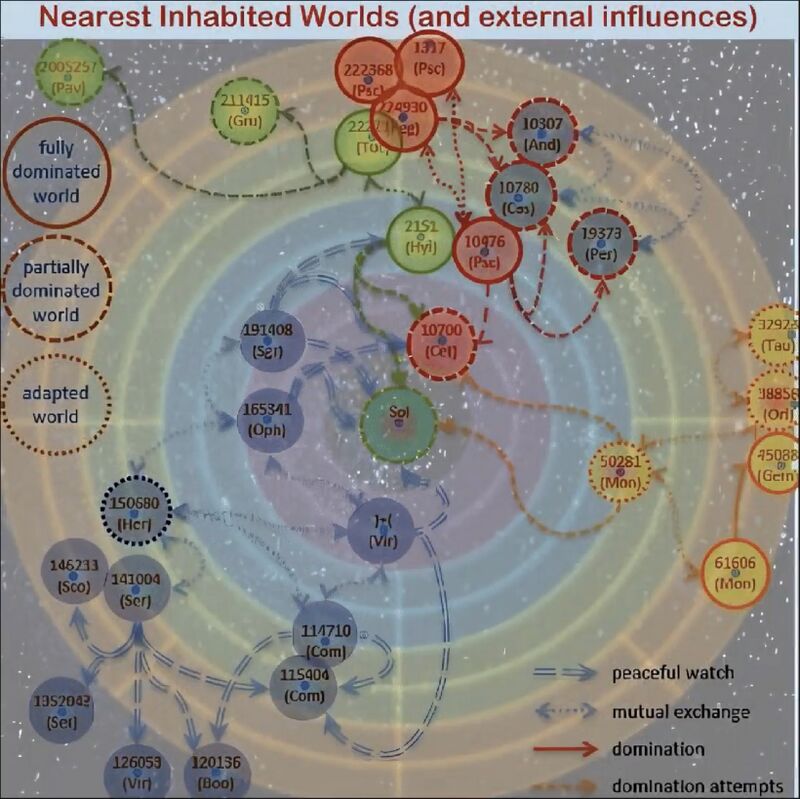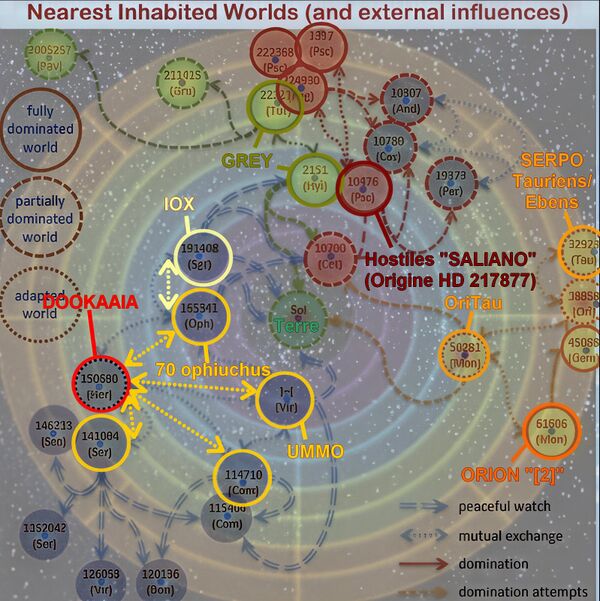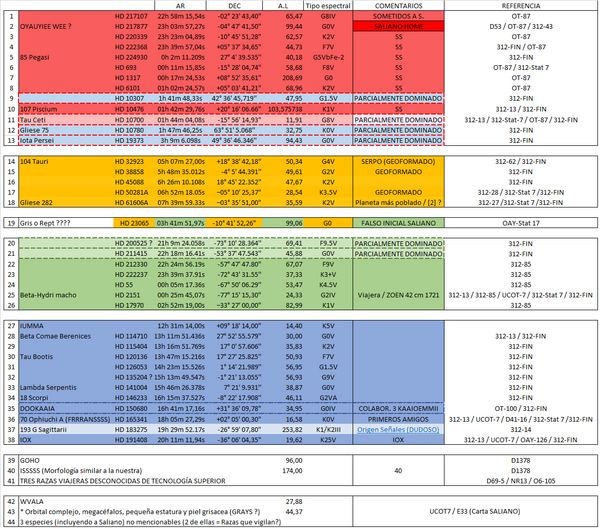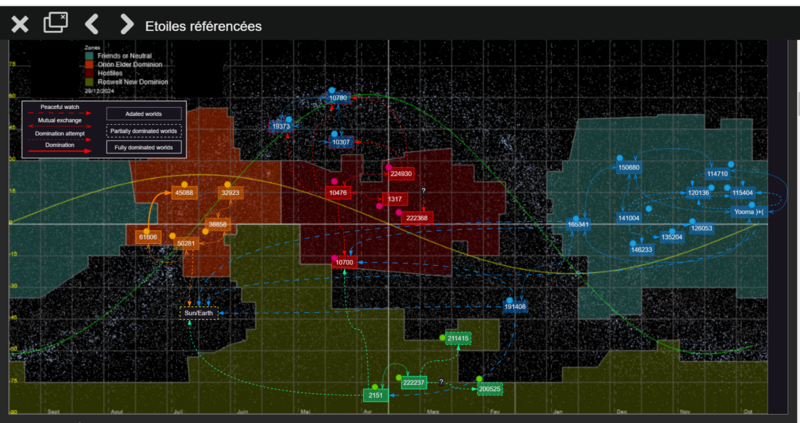Ethnies proches impliquées : Différence entre versions
(→Groupe ORANGE/ROUGE) |
(→Groupe ORANGE/ROUGE - Saliano) |
||
| Ligne 236 : | Ligne 236 : | ||
==18856 ??? - Planète adaptée== | ==18856 ??? - Planète adaptée== | ||
| − | ='''Groupe ORANGE/ROUGE | + | ='''Groupe ORANGE/ROUGE (Hostiles / Saliano)''' = |
[[Fichier:Rouge.png]] | [[Fichier:Rouge.png]] | ||
Version du 8 avril 2025 à 12:25
Page en cours d'écriture
http://oumo.fr/img/ummo_1600_3a7deb.png
Sommaire
312_oay le 281224
Image de profil de 312_oay mise à jour le 28 décembre 2024 intitulée "Mondes habités les plus proches (et influences externes)" . Dernière intervention twitter de ce compte.
Voir aussi: E.T. selon 312 oay , Accord de 1966 , Ethnies extraterrestres. Il est a noter que sur le schéma le Soleil (donc la Terre) fait partie des "Partiellement dominés"
Remerciements à https://x.com/i/status/1873113997974880740 (@Lyes)
Remerciements "ian" @fulei777
Suggestions de M.R. janvier 2025
Systèmes planétaires cités dans les documents U
Le 19/12/2024, Manuel écrit sur tweeter (X): " Mon pari serait:
- HD 42807 (49,5 a.l.) système original des Orions (https://www.universeguide.com/star/29525/v1357orionis ) - 58 al
- HD 38858 système des Tauris (https://www.universeguide.com/star/27435/hd38858 ) - 49 al
Avec liens direct avec la Terre
IUMMA )+(
- il est probable que IUMMA soit "cachée" derrière ou dans la zone de WOLF 424
- 12°31'14| 09°18'14
- 14,3 ou 14,4 al
- Constellation de la Vierge
HD 50281 - Planète adaptée (Orion/Tauri)
- HD 50281 / Gliese 250
- binaire située à 28,5 al
- constellation de la Licorne.
HD 2151 - Totalement dominée (Gris)
En lien direct avec la Terre
- HD 2151
- 24,3 a.l.
- l'Hydre mâle (Sud)
HD 191408 - (IOX ?)
- HD 191408 / Gliese 783
- 19,9 a.l
- Sagittaire
- Right ascension 20h 11m 11.9s - Declination-36° 06' 04"
HD 165341
70 Ophiuchi (en abrégé 70 Oph) est une étoile binaire située à 16,6 années-lumière de la Terre dans la constellation d'Ophiuchus.
Groupe BLEU - (Amis ou Neutres )
IUMMA )+(
- il est probable que IUMMA soit "cachée" derrière ou dans la zone de WOLF 424
- 12°31'14| 09°18'14
- 14,3 ou 14,4 al
- Constellation de la Vierge
- D21, D84
HD 165341
70 Ophiuchi 165341
- 18h02m00 +02°30'30
- 16.57
- amical
- Frrranssss -
- IEYIOBAA 0.89 88601
- D41-16 (70 du serpentaire), E33 (70 Ophucius), OT-Status 9, 312-13, 312-S9
HD 191408
Gliese 783 HD191408
- 20h11m11 /-36°06'04
- 19.62 al
- amical Iox
- 0.66 99461
- OAY-126, E33 (HR7703), 312-S9
HD 114710
- Beta Comae Berenices (β Comae Berenices, β Com)
- 29.95 light-years
- constellation Coma Berenices.
HD 115404 (amical)
amical
- HD 115404
- 36 al
- 13h16m08+17d01m02
- 312-Status 10
HD 115404 A b is a Neptune-like exoplanet that orbits a K-type star. Its mass is 30.82936 Earths, it takes 10.5 days to complete one orbit of its star, and is 0.088 AU from its star. Its discovery was announced in 2022.
HD 141004 (Amical)
- HD 141004
- 15h46m04 -07d21m11
- 39.54 Al
- 312-Status 10
HD 141004 b is a Neptune-like exoplanet that orbits a G-type star. Its mass is 13.63484 Earths, it takes 15.5 days to complete one orbit of its star, and is 0.1238 AU from its star. Its discovery was announced in 2021.
HD 150680 - Dookaïa Planète adaptée amicale
- Zeta Herculi /HD 150680
- 34,9 al
- 16h41m17 +31°36'09
- OT-100
Cet astre, originellement stérile, se situe dans le système stellaire HD 150680.
Les frères, plus avancés, qui partagent notre refuge en Antarctique n'y prennent pas part active.HD 146233 (Amical)
- HD 146233
- 45 al
- 16h15m06 -09d37m50
- 312-Status 10
HD 135204
- HD 135204
- 56 al
- 15h 13m 49s -1° 21' 13.055
HD 120136
https://simbad.u-strasbg.fr/simbad/sim-id?Ident=HD+120136
HD 126053
HD 126053 is a star located in the constellation Virgo. It is a solar analog, meaning its physical properties are similar to the Sun, although it is metal-poor. Here are some key details about HD 126053:
Distance: Approximately 57 light years from Earth.
Apparent Magnitude: 6.25, which makes it faintly visible to the naked eye under dark suburban or rural skies.
Spectral Type: G1 V, indicating it is a yellow dwarf star.
Temperature: About 5,722 K.
Mass: 0.89 times the mass of the Sun.
Radius: 0.93 times the radius of the Sun.
Luminosity: 0.83 times the luminosity of the Sun.
Age: Estimated to be around 5.49 billion years old.
In 2012, a brown dwarf was discovered orbiting HD 126053 at a distance of 2630 AU. This brown dwarf, designated as HD 126053 B, is a T-type brown dwarf with a spectral type of T8p, indicating a low temperature.
Groupe VERT (les Gris)
HD 222237 - Totalement dominée
situé 37 années-lumière du soleil. K3+V,environ 70 % de masse solaire. Il y a au moins une exoplanète dans ce système.
HD 2151 - Totalement dominée
En lien direct avec la Terre
Beta Hydri (β Hyi, β Hydri) is a star in the southern circumpolar constellation of Hydrus. (Note that Hydrus is not the same as Hydra.) With an apparent visual magnitude of 2.8,[2] this is the brightest star in the constellation. Based upon parallax measurements the distance to this star is about 24.33 light-years (7.46 parsecs). This star has about 113% of the mass of the Sun and 184% of the Sun's radius, with more than three times the Sun's luminosity
HD 211415 - Partiellement dominée
is a double star in the constellation Grus. With an apparent visual magnitude of 5.33, it is visible to the naked eye. The annual parallax shift is 72.54 mas, which yields a distance estimate of 45 light years. It has a relatively high proper motion, traversing the celestial sphere at the rate of 93.4 mas per year,[12] and is moving closer to the Sun with a radial velocity of −13 km/s.[5]
HD 200525 - Partiellement dominée
HD 200525 is a white to yellow subgiant star in the constellation of Pavo. It can be seen in the southern hemisphere night sky. HD 200525 distance from Earth is 64.47 light years away.
Groupe JAUNE (Orion-Tauri)
HD 61606 - Totalement dominée
HD 61606 is a star system located approximately 46 light years from the Sun and consists of four stars. Currently, no exoplanets are identified in this system.
Conclusions: c'est la planète [2] que les Orions ont "volé" à leur anciens amis de voyage les Tauriens/Ebens lorsque la leur est devenu invivable. Il s'agit donc du monde d'origine des Tauriens.
HD 50281 - Planète adaptée
is a star located in the equatorial constellation of Monoceros. It has an apparent visual magnitude of 6.58 and is approximately 28.5 light years away from the Sun. The star is an orange hue and has a stellar classification of K3.V, indicating it is a K-type main sequence star. It is nearly two billion years old and has a mass of about 79% of the Sun’s mass, with a radius of about 73% of the Sun’s radius. The star emits about 22.5% of the luminosity of the Sun and has an effective temperature of around 4,712 K.
HD 45088 - Totalement dominée
- High Proper Motion Star
- OU Geminorum Aa
- Orange star, BY Draconis variable
- Spectral class: K2Ve
- Ascension Right ascension: 6h 26m 10.108s
- Declination Declination: 18° 45' 22.352 (equatorial region)
- Parallax Parallax: 68.414
!Distance Sun distance: 47.674 ly | 14.6 pc
- weight Mass: 85 % M Sun
- radius Size: 81 % R Sun
- temperature : 4960 K | 0.86 T Sun
HD 32923 - Planète adaptée
104 Tauri is a white to yellow main sequence star in the constellation of Taurus. 104 Tauri distance from Earth is 50.34 light years away.
Probablement "SERPO"
18856 ??? - Planète adaptée
Groupe ORANGE/ROUGE (Hostiles / Saliano)
HD 10700 - Partiellement dominée
Location: HD10700 is a G8V star, located approximately 3.65 parsecs (12 light-years) away from the Sun in the constellation Cetus. Planetary System: At least five potentially terrestrial planet candidates have been discovered orbiting HD10700, with minimum masses ranging from 2 to 6.7 Earth masses. Chemical Composition: Abundance analysis suggests that HD10700 has a higher Mg/Si ratio (1.78) compared to the Sun (about 1.2). This could imply a different mineralogical makeup for planets around HD10700, potentially leading to oversaturation of MgO. Habitable Zone: Depending on atmospheric properties, up to two planets (e and f) may be located within the habitable zone of HD10700 at its current estimated age of 7.63 billion years. Stellar Activity: The star’s radial velocity (RV) measurements have been affected by stellar activity, which can impact exoplanet detection. A recent study used a convolutional neural network to mitigate this effect and achieve detection thresholds as low as 0.5 m/s in semi-amplitude for planets with periods ranging from 10 to 300 days.
HD 10476 - Totalement dominée
107 Piscium est une étoile située à 24,8 années-lumière de la Terre1 dans la constellation des Poissons.
C'est une naine orange de type spectral K1 V2. Elle a une taille de 80 %5 et une luminosité de 37 % celle du Soleil.
HD 224930 - Totalement dominée
85 Pegasi is a multiple star system 39.5 light years away[2] in the constellation of Pegasus. The primary component is sixth magnitude 85 Pegasi A, which is a yellow dwarf like the Sun. The secondary component, 85 Pegasi B, is a ninth magnitude orange dwarf that takes 26.28 years to orbit at 10.3 AU around the primary in an elliptical orbit. The orbital distance ranges from 6.4 AU at periastron to 14.2 AU at apastron. 85 Pegasi B may itself be a binary, with a close, faint red dwarf companion (designated 85 Pegasi Bb) separated by 2 AU from the primary (designated 85 Pegasi Ba). The mass would be 11% solar mass (M☉). All components in the star system including Star A are smaller, cooler and less massive, luminous, and metallic than the Sun and 51 Pegasi.
HD 1317 - Totalement dominée
38 Piscium is a blue to white star located in the constellation of Pisces. It is not visible to the naked eye and requires a telescope to observe. Here are some key details about Star 38 Piscium:
Distance: Star 38 Piscium is approximately 49.53 light years away from Earth.
Age: The star is estimated to be around 10.2 billion years old, with a possible range of 8.3 to 11.9 billion years.
Spectral Type: It has a spectral type of F5, indicating it is a yellow to white star.
Location: Its celestial coordinates are Right Ascension 00h 17m 24.50 and Declination +08° 52` 34.8. This places it in the equatorial region of the celestial sky, making it visible from both hemispheres.
Iron Abundance: The star has an iron abundance of -0.27, which is lower than the Sun’s iron abundance.
Temperature: Based on its spectral type, the surface temperature of Star 38 Piscium is estimated to be between 6,000 and 7,500 Kelvin.
HD 222368 - Totalement dominée
Iota Piscium (ι Piscium / ι Psc) est une étoile de la constellation des Poissons, située à environ 45 années-lumière de la Terre.
Iota Piscium est une étoile jaune-blanc de la séquence principale de type spectral F7V, un peu plus grande et brillante que le Soleil. Sa température de surface est d'environ 6 300 kelvins. Iota Piscium pourrait être variable,







